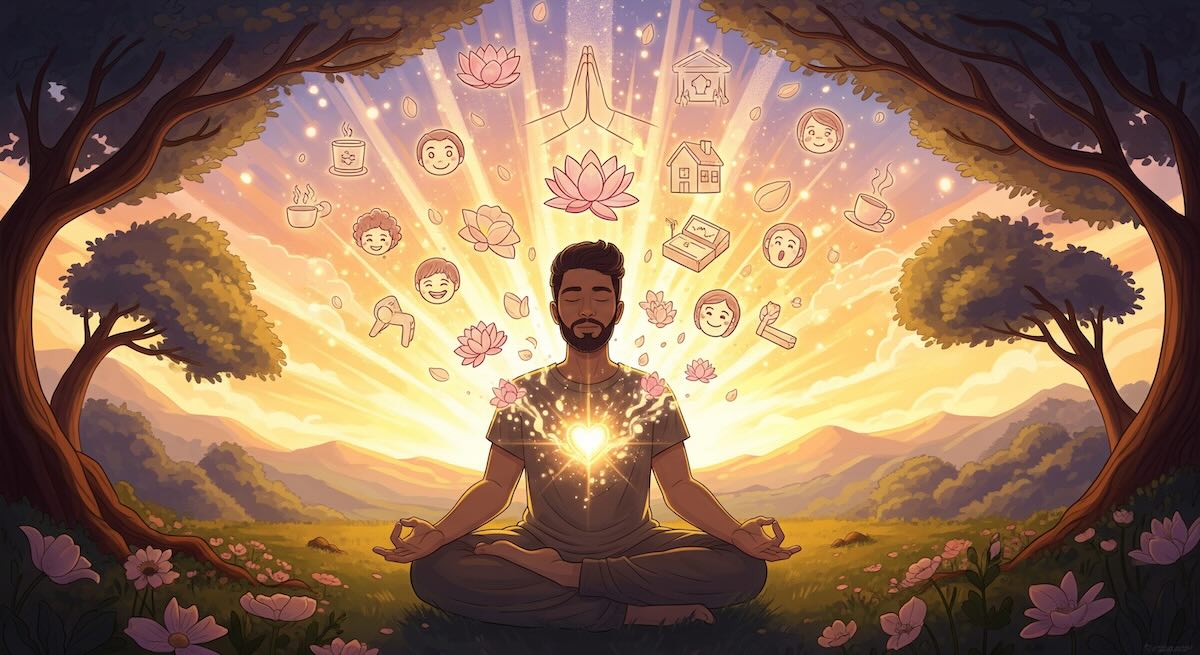In our fast-paced lives, it’s easy to focus on what’s wrong, what’s missing, or what we need to achieve next. But what if taking a few moments to appreciate what we already have could significantly boost our happiness and resilience? Cultivating gratitude is a powerful practice, and meditation provides potent tools to deepen our sense of appreciation and integrate it more fully into our lives.
This guide explores the connection between gratitude and meditation, introduces specific practices like gratitude meditation, and offers ways mindfulness can help you notice the good that’s already present.
Understanding the Connection: How Does Meditation Foster Gratitude?
Meditation enhances gratitude in several overlapping ways:
- Increases Present Moment Awareness: Mindfulness practice trains you to pay closer attention to your immediate experience. This heightened awareness allows you to notice small, everyday blessings you might otherwise overlook, the warmth of the sun, a comfortable chair, and a kind word.
- Shifts Focus from Lack to Abundance: By intentionally directing attention towards things you appreciate, meditation helps counteract the brain’s natural negativity bias (its tendency to focus on threats and problems).
- Reduces Distraction: A calmer, less cluttered mind is better able to recognize and savor positive experiences when they occur.
- Cultivates Positive Emotions: Intentionally focusing on gratitude generates feelings of warmth, connection, and contentment, which positively impact mood and outlook.
- Develops Perspective: Stepping back through meditation can help you see challenges in a broader context, making it easier to appreciate the stable, positive aspects of your life.
Meditation Practices for Cultivating Gratitude
You can practice gratitude both formally and informally:
1. Dedicated Gratitude Meditation
- Why it works: Specifically directs focus towards things you are thankful for, strengthening feelings of appreciation.
- How-to:
- Sit comfortably and take a few calming breaths.
- Begin by bringing to mind something simple you’re grateful for right now (e.g., the chair supporting you, the roof over your head, the air you breathe). Allow yourself to feel the appreciation.
- Expand your awareness: Think of people you’re grateful for (friends, family, mentors, even strangers who showed kindness). Picture them and silently thank them or send them well wishes.
- Consider skills or abilities you possess, positive experiences you’ve had, or aspects of nature you appreciate.
- Let the feeling of gratitude fill you. Rest in that feeling for a few moments before ending.
2. Mindful Appreciation Throughout the Day
- Why it works: Integrates gratitude into everyday life, making it a more consistent state of mind.
- How-to: Choose routine activities (drinking your morning coffee, walking outside, eating a meal) and make a point of noticing things to appreciate within that experience. Savor the taste, notice the colors, feel the warmth. Take 5-10 seconds to consciously acknowledge the feeling of gratitude.
3. Loving-Kindness Meditation (Metta) with Gratitude
- Why it works: Blends gratitude with compassion and connection.
- How-to: As you offer phrases of well-wishing to yourself and others, you can incorporate gratitude. For example, when thinking of a friend, you might add, “I am grateful for your presence in my life. May you be happy.”
4. Mindfulness of Breath with Gratitude Focus
- Why it works: Uses the breath as an anchor while gently steering the mind towards appreciation.
- How-to: Settle into mindful breathing. As you breathe, gently bring to mind things you are grateful for, letting them arise naturally. When your mind wanders, gently return either to the breath or to the feeling of gratitude.
Practical Tips for Enhancing Gratitude Through Meditation
- Start Small & Specific: Instead of vague “I’m grateful for my life,” focus on concrete things: “I’m grateful for the comfortable socks I’m wearing,” or “I appreciate the friend who texted me this morning.”
- Feel It in Your Body: Try to notice where you feel gratitude physically (perhaps warmth in your chest). Connecting to the physical sensation can deepen the experience.
- Keep a Gratitude Journal (Optional): Briefly jotting down 3 things you’re grateful for each day, perhaps after meditating, can reinforce the practice.
- Don’t Force It: Some days, gratitude flows easily, other days, it might feel harder. Be gentle. Focus on the intention to appreciate, even if the feeling isn’t strong.
- Notice Simple Pleasures: Train yourself to spot moments of everyday joy or ease, a good cup of tea, a moment of quiet, a completed task.
Managing Expectations
- Gratitude Doesn’t Deny Difficulty: You can feel grateful for certain things even while acknowledging challenges or pain in other areas of your life. It’s not about toxic positivity.
- It’s a Practice: Like any skill, cultivating gratitude deepens with consistent effort.
Conclusion: Opening Your Eyes to the Good
Gratitude is more than just saying “thank you”; it’s a way of seeing the world that enhances resilience, connection, and joy. Meditation provides powerful techniques to train your mind to notice and savor the good that already exists in your life. Whether through dedicated gratitude meditation or simply bringing more mindful appreciation to your daily moments, you can actively cultivate a heart full of thanks. Start today by noticing one small thing you appreciate, it’s a simple step with profound potential.




